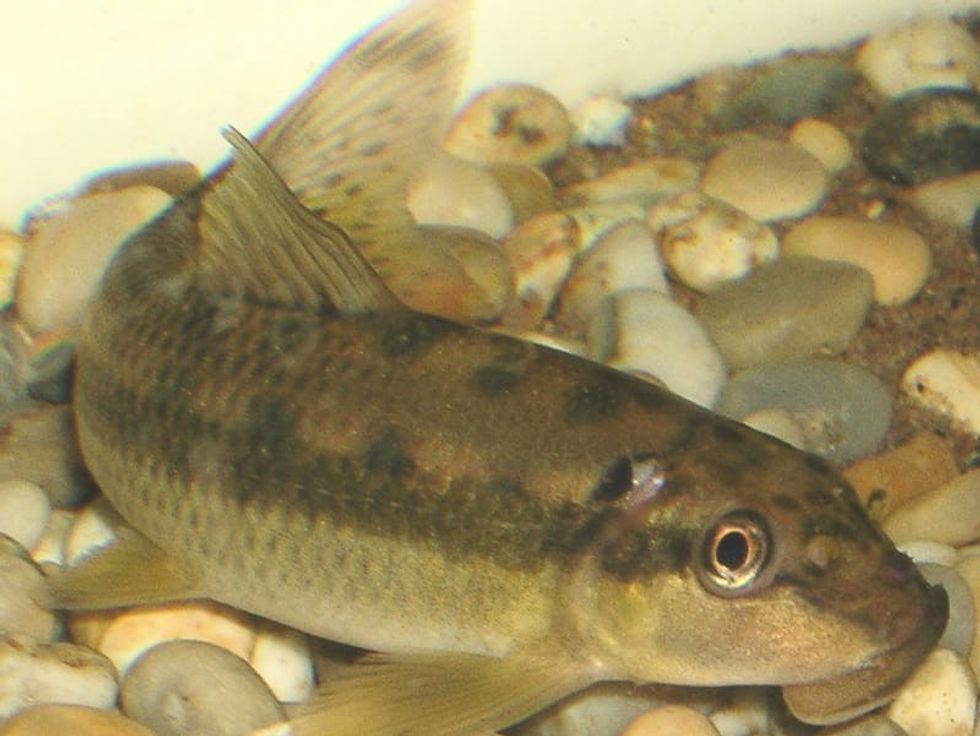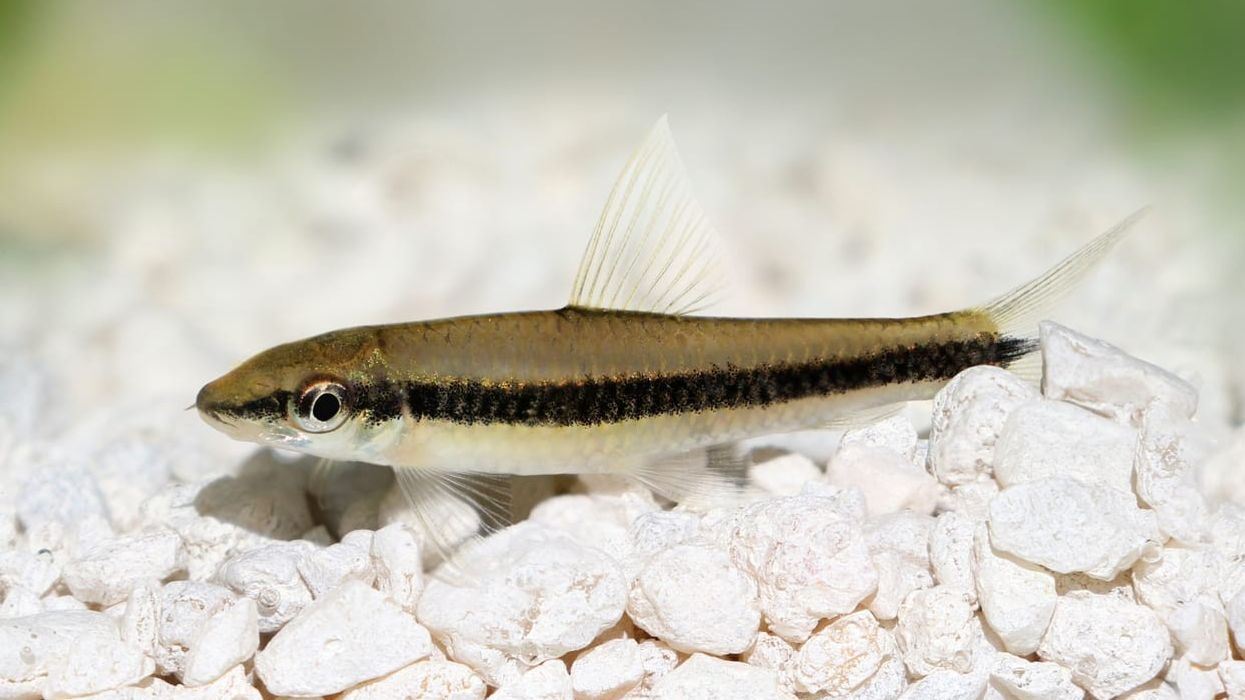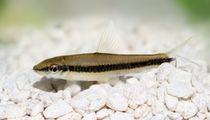Fun Siamese Algae Eater Facts For Kids

If you are looking for a docile and lively fish in your large aquarium tank that can check on the algae growth, then the Siamese Algae Eater is the one.
The school of this particular fish will stay with you for as long as 10 years with proper care in a large aquarium tank with many live plants.
It is a freshwater fish that loves to eat the black beard algae. It is preferred for its calm and peaceful nature to be kept with other fishes in a community tank.
Before bringing one home, you need to verify whether what you are getting is True Siamese or not, since you can see a black stripe even in Flying Foxes, which is another species of the same type.
The species is mainly found in Southeast Asia’s river basins but are now bred and sold at large. You can easily take care of them, and aquarists want a few in their tank with large plants.
The elongated slim body structure and silvery gray body with a horizontal black line along its length and mouth with a pout make the species one of its kind.
Read on to find more such amazing facts about the Siamese Algae Eater. Also, check out our content on rockfish and tang fish if you like this article.
Siamese Algae-eater Interesting Facts
What type of animal is a Siamese algae-eater?
The Siamese Algae Eater is a community fish. They are very docile and schools very well with its kind in an aquarium tank. The freshwater fish is peace-loving and makes good tank mates with similar species.
What class of animal does a Siamese algae-eater belong to?
The scientific name of True Siamese Algae Eater fish with a black stripe along its body’s length is Crossocheilus oblongus. The Siamese Algae Eater Crossocheilus belongs to the Actinopterygii class of the Cyprinidae family.
They are very different from the Siamese Flying Fox and the False Siamese though they are closely related as both eat algae. They are, in short, termed as SAE.
How many Siamese algae-eaters are there in the world?
The Siamese Algae Eater fish is widely found in the river basins in their habitat and also can be seen in the flooded fields as they move around with the water flow. They are also bred in abundance for aquarists.
Where does a Siamese algae-eater live?
The Siamese Algae Eater fish is found in South East Asia in the river basins of the rivers Chao Phraya and the Mekong in Thailand and Cambodia. They can also be found in the Malay Peninsula. The fishes that live in rivers and streams can also be found in flooded fields and forests during the rainy season.
If living in an aquarium, the Siamese Algae Eater tank size should be ideally 20 gallons with large plants. As they grow in length, the minimum tank size also should be increased to around 35 gallons to occupy a school of four of them.
What is a Siamese algae-eater’s habitat?
The True Siamese Algae Eater is tropical freshwater fish. They live in fast-moving streams and rivers with almost zero pH levels which is an essential factor for survival.
River or stream beds with substrates formed by sand, pebbles, and boulders with enough algae growth are the favorite spots for this bottom-dwelling species. Their natural habitat, beneath the water surface, includes logs and roots of trees and plants, and stones as they relish on algae and other microorganisms.
Who do Siamese algae-eaters live with?
Siamese Algae Eaters love to be in the company of their kind and do well if kept in a school of four to six fishes. Even otherwise, you can have a single Siamese Algae Eater in your aquarium, but a pair is recommended.
They are kept in most community tanks and do well with non-aggressive and peaceful fishes like Tetras, Danios, and Rasboras. Gouramis or Barbs, Guppies or Angel Fishes, Cory cats, or Swordtails are also beautiful companions to keep with this species.
A word of caution is that you need to keep an eye open to see if an SAE is doing well with Angle fishes and Betta. It is sometimes observed that Siamese Algae Eaters may peck on these fish fins.
So, you need to check in for their tail fin and other fins before an SAE damages them. But most often in larger tanks, they live along together well enough.
How long does a Siamese algae-eater live?
The Siamese Algae Eater's lifespan is about 10 years and can live longer if kept in a clean and healthy aquarium tank. However, the juveniles take six months to two years to grow, depending on the environment they are kept in to grow.
How do they reproduce?
The Siamese Algae Eater fish reproduces by spawning like most fishes. They reach sexual maturity around age three. In their natural habitat, the males fertilize Siamese Algae Eater eggs but breeding them outside the fish farm setup is almost unachievable.
Siamese Algae Eaters live in fast-moving well-oxygenated water with almost zero pH levels. A female is larger than a male. Little is known about how they breed in the natural environment.
A male burrows into a substrate and attracts a female by what is called tail standing and shimmying behavior into it. It isn’t easy to breed these fishes in an aquarium tank setup. But in a fish farm, they are bred successfully because of the added hormones.
What is their conservation status?
According to the IUCN Red List, Siamese Algae Eaters' conservation status is Least Concern.
Siamese Algae-eater Fun Facts
What do Siamese algae-eaters look like?
Siamese Algae Eaters have long pale silvery gray narrow and long cylindrical bodies. They have a black zig-zag black stripe running along its body's length. The tail fin and the caudal fins are bright and transparent, and the fish has a pair of whiskers named feelers or rostral barbels.

*Please note that this is an image of a Chinese Algae eater , not a Siamese Algae Eater specifically. If you have an image of a Siamese Algae Eater, then please let us know at hello@kidadl.com.
How cute are they?
The fish look cute with a dominant black stipe on its silvery-gray body. The species has a distinguished habit of resting on large aquatic plants' leaves. They attach themselves to something to stay in a place with their sucker-like mouths a thing of sight.
How do they communicate?
The fish is a peaceful fish and sometimes territorial towards its kind but do well in schools. Much is unknown about how these particular species communicate in their natural environment.
How big is a Siamese algae-eater?
Adult Siamese Algae Eaters can grow up to six inches in length. Juvelines of this species are sold when they grow to a length of about three inches.
It takes about six months to two years for juveniles to grow into full adults. Many factors like diet, quality of water, including its pH levels, and oxygen levels play an essential role in their growth.
How fast can a Siamese algae-eater swim?
Though the exact speed at which this fish swims is unknown, the fish lives in fast-moving water. Since these fishes do not have a swim bladder, they sink to the bottom if not in constant motion.
How much does a Siamese algae-eater weigh?
The exact weight of a Siamese Algae Eater full-grown fish is not available, but this species does not weigh more than a few ounces. The growth rate changes with the water changes in the environment.
What are their male and female names of the species?
The male and female species do not have any unique names for each in this species. But a group of fishes is commonly known as a school and sometimes shoal, draft, or run.
What would you call a baby Siamese algae-eater?
There is no specific term for a baby Siamese Algae Eater fish, but baby fishes are called a fry or fingerling in general.
What do they eat?
The main diet of this fish, as its name suggests, is algae. Periphyton and phytoplankton are all part of their diet. This is an omnivorous fish and eats small insects and dead fish and plants and keeps the tank clean of black beard algae.
They sometimes even eat small baby fishes found in the vicinity. Basically, they enjoy eating anything that fits in their mouths. Whether a true SAE eats a shrimp or not is a topic of discussion, but few other species like (CAE) eat shrimps.
In an aquarium tank full of plants, the fish eats bacteria and any other microorganisms growing in the tank. Algae wafers and bloodworms are their favorites among the fish food, but overfeeding it will not solve the purpose, as the fish will stop eating the algae in the tank since the fish can eat all day long.
Ideally, the fish should be fed just once a day.
Are they eaten by humans?
No, this fish is not a part of the human diet.
Would they make a good pet?
Siamese Algae Eaters are kept in an aquarium tank for their temperament (peaceful and non-aggressive). They are excellent tank mates with other peaceful fish species.
The fish is an excellent choice to keep the tank clean as they eat algae, mostly the black beard algae. The fish is kept in aquariums with plants. In a big tank set up, which is generally what this fish prefers, a school of these fishes is a must that will live for almost a decade.
Did you know...
Siamese Algae Eater vs. Flying Fox: The Flying Fox fish is also known as the Reticulated Siamese Algae Eater. The fish has two pairs of whiskers and has an extra golden stripe above the black one, unlike the former.
Chinese Algae Eater vs. Siamese Algae Eater: The CAE is larger and bright yellow compared to SAE. Golden Siamese Algae Eater is brighter and belongs to the Chinese Algae Eater family.
Here are a few points to be noted under Siamese Algae Eater care in an aquarium tank. You will need: (a) a sandy substrate, (b) fast-growing live plants, (c) tanks with lids, (d) appropriate water pH level, (e) regular checks of water hardness and water temperature, (f) tank size & tank mates.
How to identify a true Siamese algae eater
True Siamese Algae Eaters have silvery gray long, narrow bodies. The fish has a zig-zag black stripe running along the length of its body.
And unlike the plain black stripe on a Flying Fox fish, it doesn’t have a golden stripe above the black one.
Another interesting thing is that the fish is non-aggressive and school together very nicely with the other fishes of their kind, not algae eaters. The Siamese fish has only one pair of whiskers and does not develop any red tinge towards the end of the tail fin, like the Siamese Flying Fox fish.
What type of water do Siamese algae eaters prefer?
Siamese algae eaters prefer freshwater, highly oxygenated water with zero pH levels. A large biotope aquarium tank is a must to care for this fish with no swim bladders to keep it moving and stay healthy.
Here at Kidadl, we have carefully created lots of interesting family-friendly animal facts for everyone to discover! Learn more about some other fish including teira batfish, or neon tetra.
You can even occupy yourself at home by drawing one on our Siamese algae eater coloring pages.
We Want Your Photos!
More for You
See All
Bachelor of Science specializing in Mass Communication.

Adekunle Olanrewaju JasonBachelor of Science specializing in Mass Communication.
Bachelor of Arts specializing in English Language and Literature, Master of Arts specializing in Philosophy and Religious Studies

Tehil DavidBachelor of Arts specializing in English Language and Literature, Master of Arts specializing in Philosophy and Religious Studies
Tehil David Singh is a fact checker with a Bachelor's degree in English literature from St.Xavier's College, Palayamkottai, and a Master's degree in Philosophy, and Religion from Madurai Kamaraj University. He has a passion for writing and hopes to become a story writer in the future. Tehil has previously interned in content writing and has been a content creator for the last three years. In his personal life, he enjoys singing, songwriting, performing, and writing stories.
Disclaimer
1) Kidadl is independent and to make our service free to you the reader we are supported by advertising. We hope you love our recommendations for products and services! What we suggest is selected independently by the Kidadl team. If you purchase using the Buy Now button we may earn a small commission. This does not influence our choices. Prices are correct and items are available at the time the article was published but we cannot guarantee that on the time of reading. Please note that Kidadl is a participant in the Amazon Services LLC Associates Program, an affiliate advertising program designed to provide a means for sites to earn advertising fees by advertising and linking to Amazon. We also link to other websites, but are not responsible for their content.
2) At Kidadl, we strive to recommend the very best activities and events. We will always aim to give you accurate information at the date of publication - however, information does change, so it’s important you do your own research, double-check and make the decision that is right for your family. We recognise that not all activities and ideas are appropriate for all children and families or in all circumstances. Our recommended activities are based on age but these are a guide. We recommend that these ideas are used as inspiration, that ideas are undertaken with appropriate adult supervision, and that each adult uses their own discretion and knowledge of their children to consider the safety and suitability. Kidadl cannot accept liability for the execution of these ideas, and parental supervision is advised at all times, as safety is paramount. Anyone using the information provided by Kidadl does so at their own risk and we can not accept liability if things go wrong.
3) Because we are an educational resource, we have quotes and facts about a range of historical and modern figures. We do not endorse the actions of or rhetoric of all the people included in these collections, but we think they are important for growing minds to learn about under the guidance of parents or guardians.







